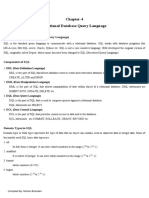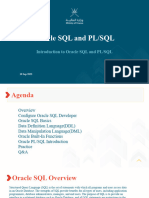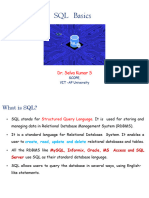0% found this document useful (0 votes)
86 views3 pagesDDL or Data Definition Language
DDL commands are used to define and modify the structure of database objects like tables and indexes, but not the data itself. Common DDL commands include CREATE, ALTER, DROP, TRUNCATE, and COMMENT. DML commands like INSERT, UPDATE, and DELETE are used to manipulate the data within database tables. SELECT is the main SQL statement for querying and viewing data. Examples show how to create a database and table, insert data, and perform basic queries using SELECT with clauses like WHERE, GROUP BY, and ORDER BY.
Uploaded by
opbhio439Copyright
© © All Rights Reserved
We take content rights seriously. If you suspect this is your content, claim it here.
Available Formats
Download as PDF, TXT or read online on Scribd
0% found this document useful (0 votes)
86 views3 pagesDDL or Data Definition Language
DDL commands are used to define and modify the structure of database objects like tables and indexes, but not the data itself. Common DDL commands include CREATE, ALTER, DROP, TRUNCATE, and COMMENT. DML commands like INSERT, UPDATE, and DELETE are used to manipulate the data within database tables. SELECT is the main SQL statement for querying and viewing data. Examples show how to create a database and table, insert data, and perform basic queries using SELECT with clauses like WHERE, GROUP BY, and ORDER BY.
Uploaded by
opbhio439Copyright
© © All Rights Reserved
We take content rights seriously. If you suspect this is your content, claim it here.
Available Formats
Download as PDF, TXT or read online on Scribd
/ 3
























































































